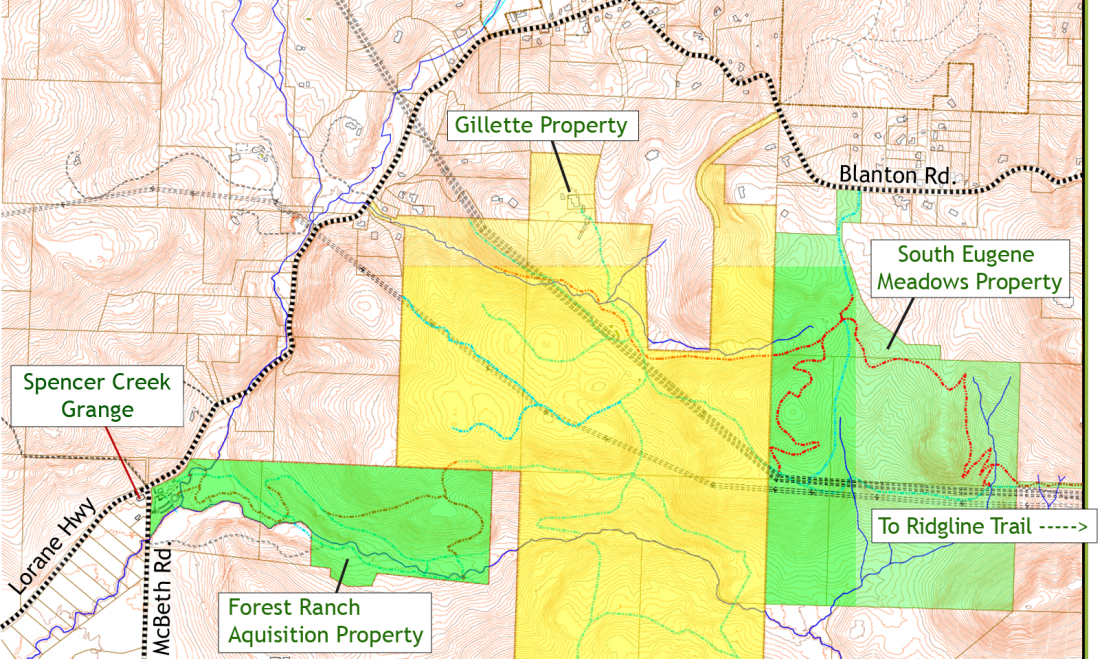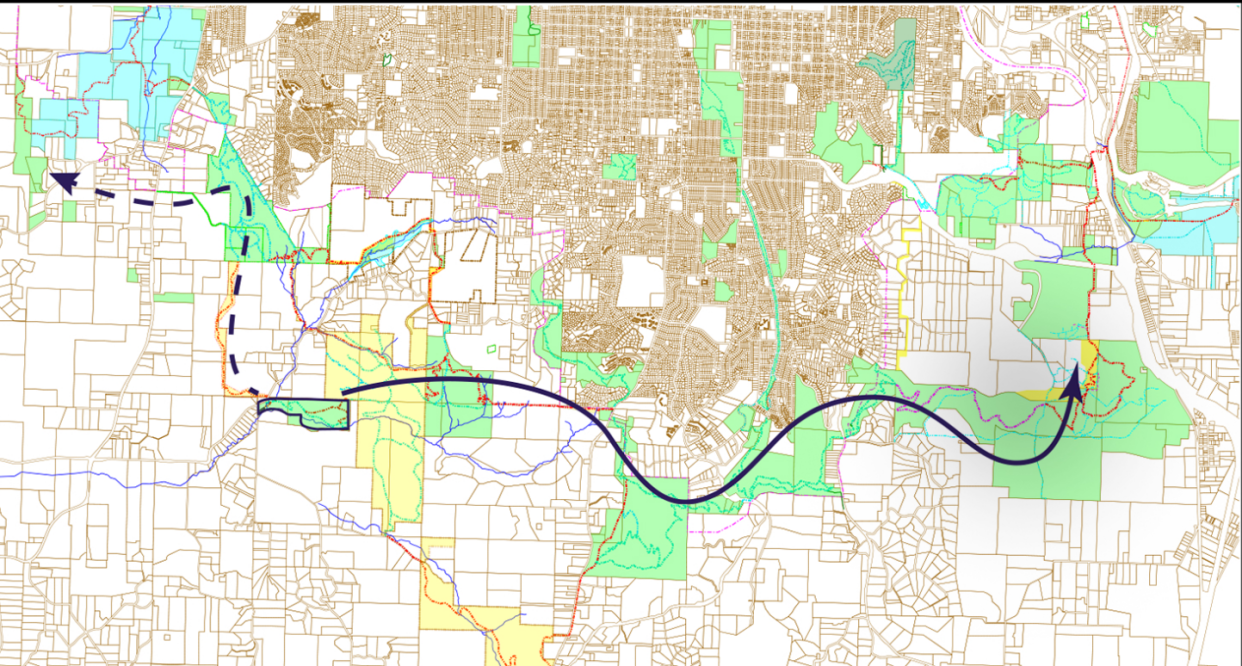Eugene’s next big park? Forest Ranch property takes key step
A serene slice of paradise west of Spencer Butte lies near the top of the Eugene Parks Foundation’s current project list. The property’s acres upon acres of mature trees are about a 15-minute drive southwest from downtown Eugene, with the potential to become an accessible escape to tranquility.
To-do: Acquire the Forest Ranch Park property.
EPF recently received an $800,000 matching donor grant that will be used to procure a property slated to become the Forest Ranch Park. The 73-acre property has not been timbered for over 75 years, allowing a lush landscape of mature pine trees, open meadows and abundant wildlife to thrive. Located across from the Spencer Creek Grange near Lorane Highway and McBeth Road, the property provides an opportunity for recreators to escape the bustle of Eugene into a serene patch of nature just outside the city.
The eventual acquisition of this property furthers the region’s greater Rivers to Ridges vision, which includes a coalition of organizations collaborative to restore, preserve and manage open spaces in the Willamette Valley. An integral piece of this vision is the intent to connect open, green spaces, effectively integrating connectivity across all of our region’s natural landscapes — literally from rivers to ridges. Eventually, uninterrupted trails are planned to connect all the way across Eugene, from Fern Ridge Reservoir in the west to Mt. Pisgah out east.
Much of this work is done collaboratively between the city of Eugene and the Eugene Parks Foundation, including the naming process for the property. The current name calls the space the Forest Ranch Park, but as the project evolves, it may adopt a new, permanent name later down the line.

Ariel Lissman, Eugene Parks Foundation’s executive director, called the matching grant donation “mind-blowing” and said it is the single largest donation the foundation has ever received. He said the total project will cost $1.2 million to acquire and stabilize the land. Once that work is complete, the Eugene Parks Foundation intends to gift the property to the city of Eugene for future development and stewardship.
“It’s not going to be open to the public for a few years because there is some planning, permitting, but it goes on the city’s inventory of future parks development and hopefully with the next parks bond, this project will get in,” Lissman said.
The closest trail system connection to the Forest Ranch Property is the South Eugene Meadows, complete with 193.7 acres of woodlands, prairie and savanna to explore. But before trails can connect Forest Ranch Park to the South Eugene Meadows, a private property named in project documents as the Gillette property, located between the two parks, must be purchased. Lissman said project coordinators are at the mercy of these landowners.
“I think what will motivate everyone — the Eugene Parks Foundation, the city of Eugene and private donors — to fund the next phase, which is building the trail, building that opportunity, is if we get the Gillette property,” Lissman said. “So that’s when we’re going to make lots of connections.”
Philip Richardson, Eugene Parks and Open Space landscape architect, said one of his favorite parts of his multifaceted role is working on land acquisition for the city’s parks system. He said the nature of land acquisition is opportunistic, so when an opportunity to connect park land arises, staff members need to move quickly and have funding ready to finalize purchases.
The long-term vision for Eugene and the greater region’s recreational system plans comes from the city’s Parks and Recreation System Plan and the Rivers to Ridges Metropolitan Regional Parks and Open Space Plan, respectively. These plans are informed by public input.

Richardson said making progress toward goals outlined in large plans like these takes time.
“Typically for our park projects, we sort of think of a three-year timeline — a year to plan, a year to put the construction documents all together and then a year to actually build,” Richardson said. “It doesn’t always take that long, but sometimes it takes longer.”
Richardson cited the example of Spencer Butte, which the city purchased in 1939, as an example of the type of long-term planning it can take to see a large-scale trail connection project come to fruition.
“Here it is 80-some-odd years later and we’re still working on finishing it and connecting all the pieces,” Richardson said of the Spencer Butte purchase and Ridgeline connection efforts. “You have to think in those timeframes.”
While patience remains a constant need when developing parklands, Richardson says the virtue of patience pays off when projects are completed.
“When you acquire a parcel and you see a trail get developed on it or a park get put on it and you start to see people enjoying it, there’s just no better feeling so I do love that aspect of the work,” Richardson said. “I love the public service aspect and I think that’s true of every single person in this office. I think that’s why we’re here.”
Richardson said the city’s partnership with the Eugene Parks Foundation is relatively new, but that it shows a lot of exciting potential for future developments across Eugene’s parks and open spaces inventory as it adapts to changing community needs and expands over time.
“I think this relationship with EPF is still in the early stages,” Richardson said. “I think the possibility is great and we’d like to see some really positive winds to demonstrate to other potential donors that we can do this and this could make for a great system that the community will love.”
More information about the Forest Ranch Park project, including how possible donors can schedule a visit, can be found at www.eugeneparksfoundation.org.
Hannarose McGuinness is The Register-Guard’s growth and development reporter. Contact her at hmcguinness@registerguard.com
This article originally appeared on Register-Guard: Eugene Parks Foundation secures $800k for Forest Ranch Park
